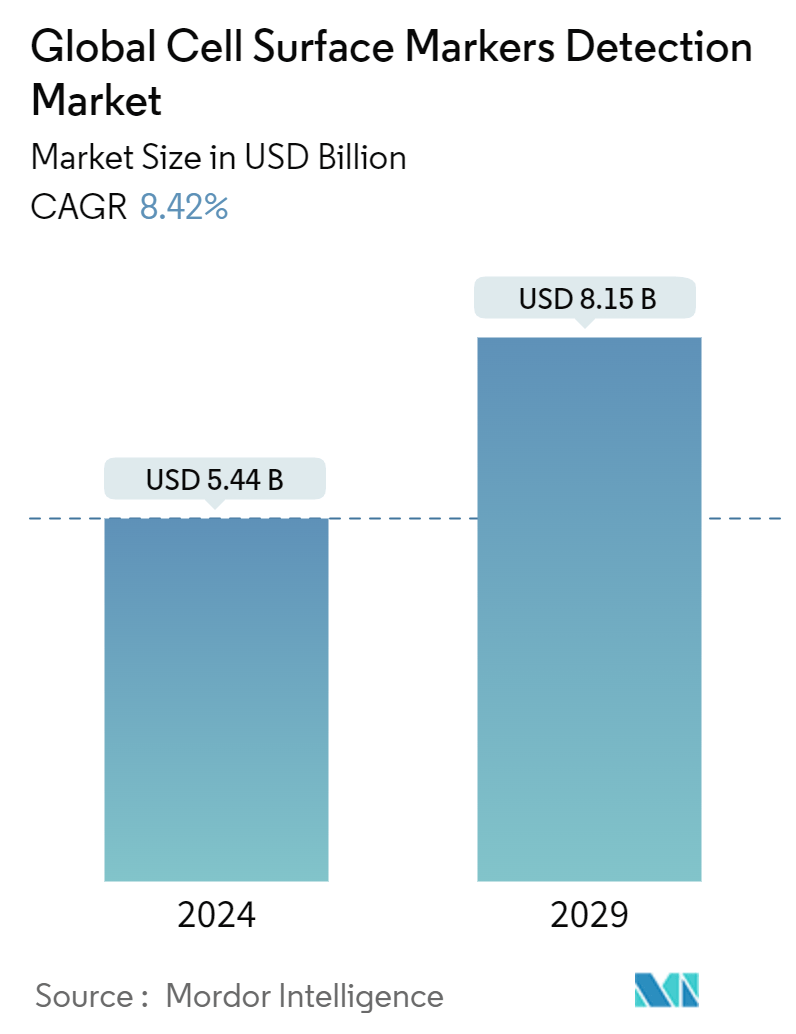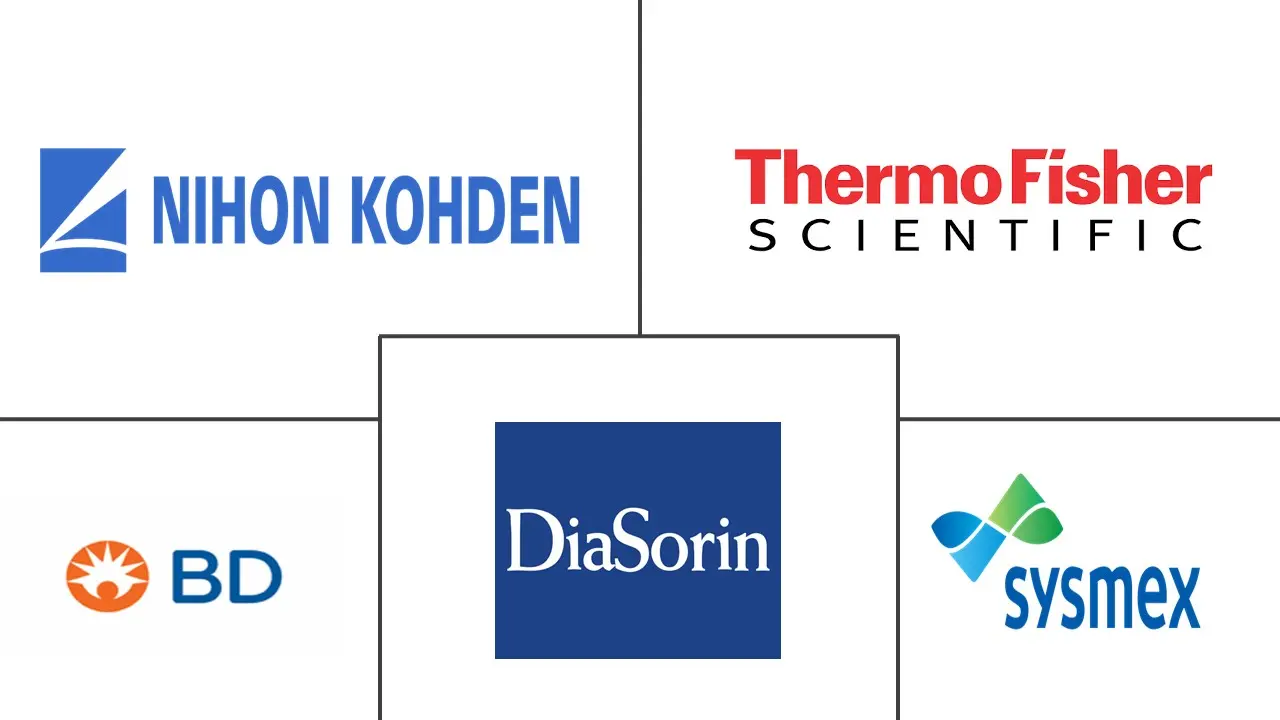Market Size of Global Cell Surface Markers Detection Industry

| Study Period | 2019 - 2029 |
| Market Size (2024) | USD 5.44 Billion |
| Market Size (2029) | USD 8.15 Billion |
| CAGR (2024 - 2029) | 8.42 % |
| Fastest Growing Market | Asia-Pacific |
| Largest Market | North America |
| Market Concentration | Low |
Major Players
*Disclaimer: Major Players sorted in no particular order |
Cell Surface Markers Detection Market Analysis
The Global Cell Surface Markers Detection Market size is estimated at USD 5.44 billion in 2024, and is expected to reach USD 8.15 billion by 2029, growing at a CAGR of 8.42% during the forecast period (2024-2029).
The COVID-19 pandemic had a significant impact on the market. Many research projects were carried out that involved the interaction of COVID-19 antibodies with cell surface markers. For instance, in February 2021, a research article published in Frontiers in Immunology studied and compared the cell surface marker expression on the monocytes of COVID-19 patients with healthy controls. The study found an increased rate of fungal co-infections in COVID-19 patients. The rate of secondary fungal infections increased in many COVID-19 patients due to their decreased immunity.
Additionally, according to an article published by the National Library of Medicine in December 2021, differences in the immune response point towards different COVID-19-specific immune markers that correlate with disease severity and are employed for the optimization of flow cytometry assays for the diagnosis and monitoring of COVID-19 progression. The study further stated that these markers could elucidate the underlying causes of different responses that could arise from a history of previous similar infections or genetic, individual, and environmental differences. Therefore, due to the advantage, the demand for cell surface markers detection increased during the COVID-19 pandemic and is expected to grow in the coming period.
The major factors driving the market's growth include the increasing demand for precision medicine, increased use of diagnostics, and technological advances related to increased throughput and automation. For instance, according to the study published in Frontiers in Cell and Developmental Biology in January 2021, high-content screening has aided in the comprehension of varied downstream effects for multiple treatments on cancer cells, specifically organelle targets, estimating the overall cellular response efficiently for new candidate molecules, and evaluating signaling heterogeneity. The rising use in understanding cancer cell response to novel drugs is expected to drive market growth.
Furthermore, the development of innovative products is also contributing to market growth. For instance, in June 2021, Leica Microsystems launched the Leica Nano workflow, a new live-cell correlative light, and electron microscopy (CLEM) workflow solution designed to increase experimental success rates, improve reproducibility, and simplify light and electron microscopy (EM) integration. Also, in October 2021, BD Life Sciences-Biosciences, in collaboration with Christian Medical College, Vellore, launched its second Center of Excellence (CoE) in flow cytometry for clinical research in India. Such developments boost the demand for cell surface markers detection, thereby driving the market growth.
However, the instruments' high cost and the techniques' complexity restrain the market growth.
Cell Surface Markers Detection Industry Segmentation
As per the scope of this report, cell surface markers detection refers to the separation and identification of target cells using analytical methods and processes, such as flow cytometry. The Cell Surface Markers Detection Market is segmented by Product (Flow Cytometry, Hematology Analyzers, Cell Imaging Systems, Reagents and Kits, and Other Products), Application (Disease Diagnosis and Identification, Research, and Drug Discovery, and Other Applications), and Geography (North America, Europe, Asia-Pacific, Middle East and Africa, and South America). The market report also covers the estimated market sizes and trends for 17 countries across major regions globally. The report offers the value in USD million for the above segments.
| Product | |
| Flow Cytometry | |
| Hematology Analyzers | |
| Cell Imaging Systems | |
| Reagents and Kits | |
| Other Products |
| Application | |
| Disease Diagnosis and Identification | |
| Research and Drug Discovery | |
| Other Applications |
| Geography | ||||||||
| ||||||||
| ||||||||
| ||||||||
| ||||||||
|
Global Cell Surface Markers Detection Market Size Summary
The cell surface markers detection market is poised for significant growth, driven by the increasing demand for precision medicine and advancements in diagnostic technologies. The market has experienced a surge in interest due to its applications in understanding immune responses, particularly during the COVID-19 pandemic, which highlighted the importance of cell surface markers in diagnosing and monitoring disease progression. Technological innovations, such as high-content screening and new microscopy workflows, have further propelled market expansion by enhancing the understanding of cellular responses and improving experimental outcomes. Despite the high costs and complexity of the instruments used, the market continues to grow, supported by the development of innovative products and strategic collaborations among key industry players.
North America is expected to maintain its dominance in the cell surface markers detection market, bolstered by a robust biotech industry, well-established research institutions, and supportive government initiatives. The region's market growth is further enhanced by the presence of major companies and their strategic partnerships, which facilitate the introduction of advanced technologies and products. The market is characterized by a fragmented landscape with numerous global and regional players, including prominent companies like Becton, Dickinson and Company, Nihon Kohden Corporation, and Thermo Fisher Scientific Inc. These companies are actively involved in launching new products and expanding their market presence, contributing to the overall growth of the cell surface markers detection market.
Global Cell Surface Markers Detection Market Size - Table of Contents
-
1. MARKET DYNAMICS
-
1.1 Market Overview
-
1.2 Market Drivers
-
1.2.1 Increased Use of Cell Surface Markers Detection in Diagnostics
-
1.2.2 Technological Advances Related to Increased Throughput and Automation
-
1.2.3 Increasing Demand for Precision Medicine
-
-
1.3 Market Restraints
-
1.3.1 High Cost of Instruments
-
1.3.2 Complexity of Techniques
-
-
1.4 Porter Five Forces
-
1.4.1 Threat of New Entrants
-
1.4.2 Bargaining Power of Buyers/Consumers
-
1.4.3 Bargaining Power of Suppliers
-
1.4.4 Threat of Substitute Products
-
1.4.5 Intensity of Competitive Rivalry
-
-
-
2. MARKET SEGMENTATION (Market Size by Value - USD Million)
-
2.1 Product
-
2.1.1 Flow Cytometry
-
2.1.2 Hematology Analyzers
-
2.1.3 Cell Imaging Systems
-
2.1.4 Reagents and Kits
-
2.1.5 Other Products
-
-
2.2 Application
-
2.2.1 Disease Diagnosis and Identification
-
2.2.2 Research and Drug Discovery
-
2.2.3 Other Applications
-
-
2.3 Geography
-
2.3.1 North America
-
2.3.1.1 United States
-
2.3.1.2 Canada
-
2.3.1.3 Mexico
-
-
2.3.2 Europe
-
2.3.2.1 Germany
-
2.3.2.2 United Kingdom
-
2.3.2.3 France
-
2.3.2.4 Italy
-
2.3.2.5 Spain
-
2.3.2.6 Rest of Europe
-
-
2.3.3 Asia-Pacific
-
2.3.3.1 China
-
2.3.3.2 Japan
-
2.3.3.3 India
-
2.3.3.4 Australia
-
2.3.3.5 South Korea
-
2.3.3.6 Rest of Asia-Pacific
-
-
2.3.4 Middle East and Africa
-
2.3.4.1 GCC
-
2.3.4.2 South Africa
-
2.3.4.3 Rest of Middle East and Africa
-
-
2.3.5 South America
-
2.3.5.1 Brazil
-
2.3.5.2 Argentina
-
2.3.5.3 Rest of South America
-
-
-
Global Cell Surface Markers Detection Market Size FAQs
How big is the Global Cell Surface Markers Detection Market?
The Global Cell Surface Markers Detection Market size is expected to reach USD 5.44 billion in 2024 and grow at a CAGR of 8.42% to reach USD 8.15 billion by 2029.
What is the current Global Cell Surface Markers Detection Market size?
In 2024, the Global Cell Surface Markers Detection Market size is expected to reach USD 5.44 billion.

